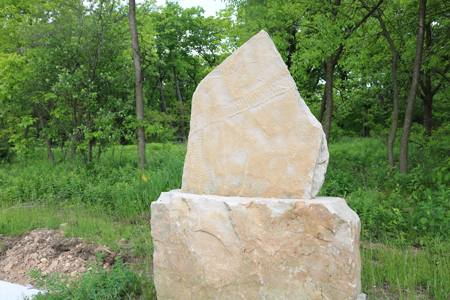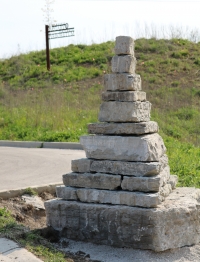It’s really cool, and I can’t wait for you to check it out!
The 3 Billion Year Walk* is a new path of rock sculptures or cairns, some as high as seven feet tall, leading people from our Riverside Park branch to the canoe launch on the Milwaukee River. Starting at the building, head west until you see the first cairn made from of 340-million-year-old stone at the gravel drive that leads to the warehouse. Follow the winding path until you find the ninth and final stone structure that’s made from rock over 3 billion years old. Together, they are a visual story of the vastness of time.
Not only are these rock cairns a geological story of Wisconsin’s past, but they are also a story of our present. Devonian Dolomite supports the oldest and iconic buildings of Milwaukee and Red Granite is part of their walls.

Nic Tompkins, the stone mason who built the entrance arch to the Milwaukee Rotary Centennial Arboretum, is the creator of these cairns. He hunted all over Wisconsin for these rocks so that you can experience a unique version of Wisconsin’s history. Many thanks go out to Nic as well as the committee of volunteers who helped over four years ago to complete this project.
Below are the cairns to look for:
Devonian Dolomite — 390 million years old — Devonian Period. The youngest bedrock in Wisconsin. This limestone, great for building, was once quarried near what is now the UWM parking lot on Capitol Drive.
Silurian Dolomite — 420 million years old — Silurian Period. Formed from coral reefs and shells of sea animals this rock runs along the eastern edge of Wisconsin then dips below Lake Michigan to rise all the way over in Niagara Falls!
Cambrian Sandstone — 510-520 million years old — Cambrian Period. Wisconsin once lay near the equator, covered by shallow tropical seas. Rock from this period is in the gorges and cliffs of Wisconsin Dells.
Basalt — 1.1 billion years ago — Middle Proterozoic Eon. When the earth’s crust in northwestern Wisconsin began to tear apart it threatened to tear North America in half and basaltic lavas erupted. Basalt is used for building railway lines and road bases or, when cut and polished, for floor tiles.
Red Sandstone — 1.1 billion years old — Middle Proterozoic Eon. Pre-dating any evidence of fossils, it’s tinted by iron oxide from the first rising of oxygen in ancient seas. It’s known as the Keweenaw Sandstone and was quarried during the 1800’s “brownstone” era of architecture.
Baraboo Quartzite — 1.7 billion years old — Lower Proterozoic Eon. This started as pure quartz sand and after hardening into sandstones, it then was changed by pressure and heat to pink, maroon and purple by iron particles. Smoothed, rounded monadnocks of quartzite as much as 4000 feet thick are in Rib Mountain.
Red Granite — 1.8 billion years ago — Lower Proterozoic Eon. Granite gneisses formed the beginning of North America. When Wisconsin was covered by a sea and a chain of volcanic islands, the islands collided with the old continent, causing Penokee Range of north-central Wisconsin. Red granite is the Wisconsin state rock.
Banded Iron Formation — 1.9 billion years ago — Lower Proterozoic. Formed in lagoons or shallow coastal waters where dissolved iron in sea water interacts with free oxygen and magnetite (iron oxide) mixes with chert (silica) to settle to the sea floor in layers of hard sedimentary rock. You can see this formation along Lake Superior.
Nephrite Jade — Precambrian Eon. Jade is Precambrian as is the banded iron on this cairn. This is from the oldest era of Wisconsin, perhaps as old as 3 billion years!
The Walk is nearing completion with eight of the nine cairns installed so come take a look! It is sure to put your lifespan on earth into perspective.
*The trail has not officially been named as of yet, so let us know if you have an idea at This email address is being protected from spambots. You need JavaScript enabled to view it..





